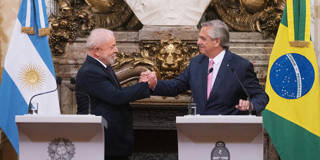Brazilian President Luiz Inácio Lula da Silva and his Argentinian counterpart, Alberto Fernández, have advanced a vision of a shared unit of account for Latin America. The goal is achievable, as long as leaders heed the lessons of economic history – in particular, the evolution of the European Currency Unit.
SÃO PAULO – Brazil and Argentina have announced plans to launch technical studies aimed at laying the groundwork for greater regional financial integration, with the ultimate goal of creating a common currency, called the “sur” (south). While the goal may seem distant, it is far from impossible.
For now, the sur is less a concrete project than a symbolic statement. It is a political call for independence from the US dollar – whose dominance in the global trading system grants the United States what Valéry Giscard d’Estaing, then France’s finance minister, famously called an “exorbitant privilege” – and US-led international payments platforms, such as the SWIFT financial-messaging system.
Ultimately, however, it is a practical goal, shared by recently elected Brazilian President Luiz Inácio Lula da Silva and his Argentinian counterpart, Alberto Fernández. Relying on a third currency – the dollar – to settle trade payments and financial transactions decreases efficiency and increases costs. In an increasingly fragmented world shaped by great-power competition, it also leaves countries vulnerable to geopolitics-driven policy changes. The sur is meant as a kind of “exit strategy” – a means of escaping the current global monetary (dis)order.

SÃO PAULO – Brazil and Argentina have announced plans to launch technical studies aimed at laying the groundwork for greater regional financial integration, with the ultimate goal of creating a common currency, called the “sur” (south). While the goal may seem distant, it is far from impossible.
For now, the sur is less a concrete project than a symbolic statement. It is a political call for independence from the US dollar – whose dominance in the global trading system grants the United States what Valéry Giscard d’Estaing, then France’s finance minister, famously called an “exorbitant privilege” – and US-led international payments platforms, such as the SWIFT financial-messaging system.
Ultimately, however, it is a practical goal, shared by recently elected Brazilian President Luiz Inácio Lula da Silva and his Argentinian counterpart, Alberto Fernández. Relying on a third currency – the dollar – to settle trade payments and financial transactions decreases efficiency and increases costs. In an increasingly fragmented world shaped by great-power competition, it also leaves countries vulnerable to geopolitics-driven policy changes. The sur is meant as a kind of “exit strategy” – a means of escaping the current global monetary (dis)order.